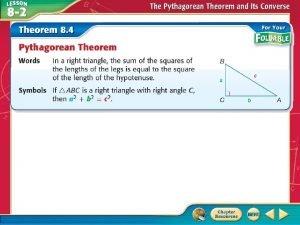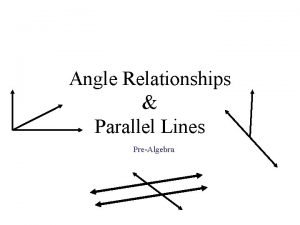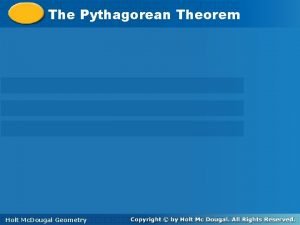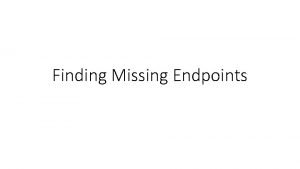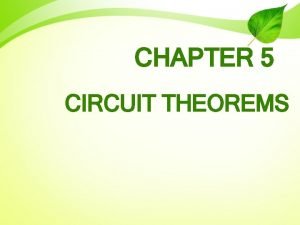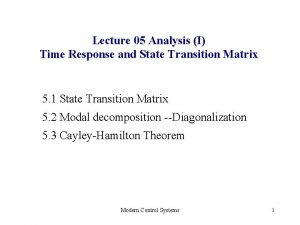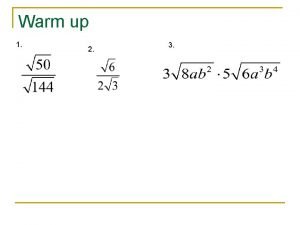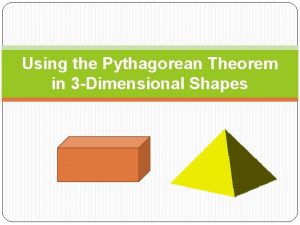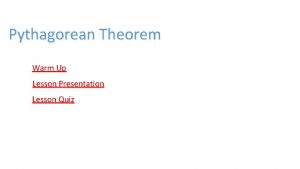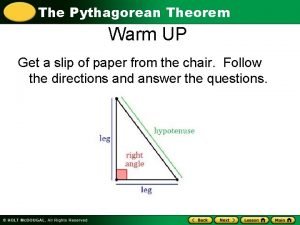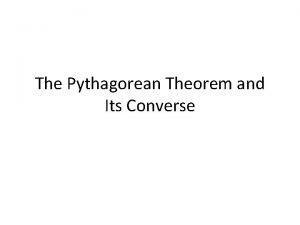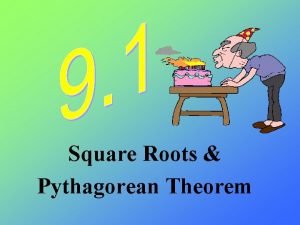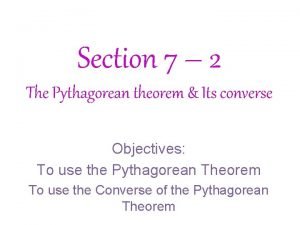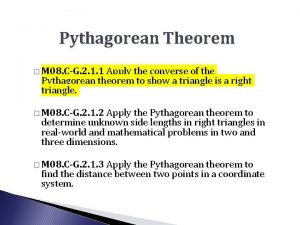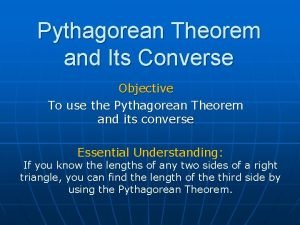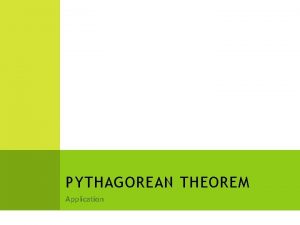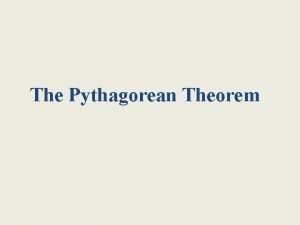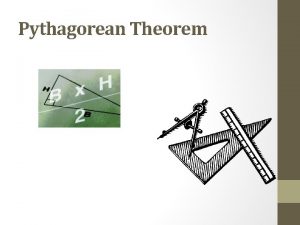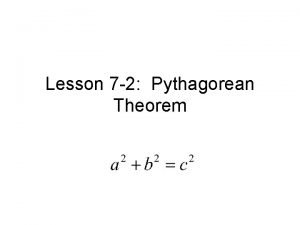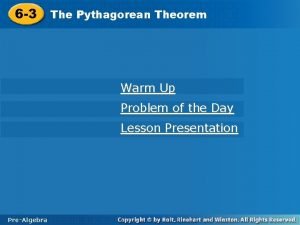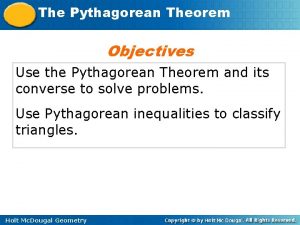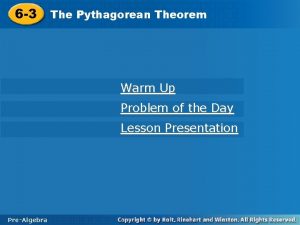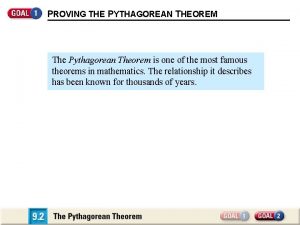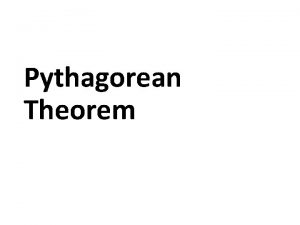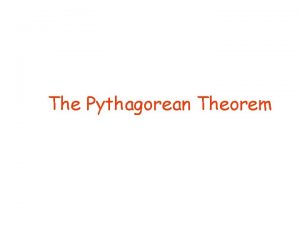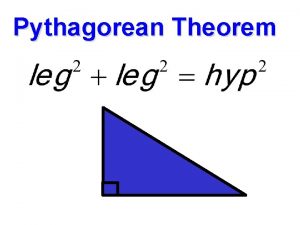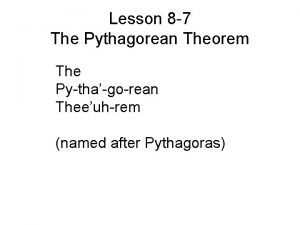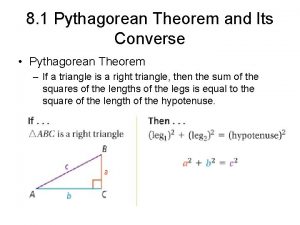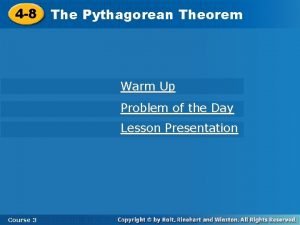Find Missing Measures Using the Pythagorean Theorem A






















- Slides: 22



Find Missing Measures Using the Pythagorean Theorem A. Find x. The side opposite the right angle is the hypotenuse, so c = x. a 2 + b 2= c 2 Pythagorean Theorem 42 + 72= c 2 a = 4 and b = 7

Find Missing Measures Using the Pythagorean Theorem 65 = c 2 Simplify. Take the positive square root of each side. Answer:

Find Missing Measures Using the Pythagorean Theorem B. Find x. The hypotenuse is 12, so c = 12. a 2 + b 2= c 2 Pythagorean Theorem x 2 + 82 = 122 b = 8 and c = 12

Find Missing Measures Using the Pythagorean Theorem x 2 + 64 = 144 Simplify. x 2 Subtract 64 from each side. = 80 Take the positive square root of each side and simplify. Answer:

A. Find x. A. B. C. D. A B C D

B. Find x. A. B. C. D. A B C D


Use a Pythagorean Triple Use a Pythagorean triple to find x. Explain your reasoning.

Use a Pythagorean Triple Notice that 24 and 26 are multiples of 2 : 24 = 2 ● 12 and 26 = 2 ● 13. Since 5, 12, 13 is a Pythagorean triple, the missing length x is 2 ● 5 or 10. Answer: Check: x = 10 2 ? 2 24 + 10 = 262 676 = 676 Simplify. Pythagorean Theorem

Use a Pythagorean triple to find x. A. 10 B. 15 C. 18 D. 24 A. B. C. D. A B C D

A 20 -foot ladder is placed against a building to reach a window that is 16 feet above the ground. How many feet away from the building is the bottom of the ladder? A 3 B 4 C 12 D 15

A 10 -foot ladder is placed against a building. The base of the ladder is 6 feet from the building. How high does the ladder reach on the building? A. 6 ft B. 8 ft C. 9 ft D. 10 ft A. B. C. D. A B C D



Classify Triangles A. Determine whether 9, 12, and 15 can be the measures of the sides of a triangle. If so, classify the triangle as acute, right, or obtuse. Justify your answer. Step 1 Determine whether the measures can form a triangle using the Triangle Inequality Theorem. 9 + 12 > 15 9 + 15 > 12 + 15 > 9 The side lengths 9, 12, and 15 can form a triangle.

Classify Triangles Step 2 Classify the triangle by comparing the square of the longest side to the sum of the squares of the other two sides. 2 ? c b 2. ? 152 = a 2 + b 2 Compare c 2 and a 2 + = 122 + 92 Substitution 225 = 225 Simplify and compare. Answer: Since c 2 = a 2 + b 2, the triangle is right.

Classify Triangles B. Determine whether 10, 11, and 13 can be the measures of the sides of a triangle. If so, classify the triangle as acute, right, or obtuse. Justify your answer. Step 1 Determine whether the measures can form a triangle using the Triangle Inequality Theorem. 10 + 11 > 13 10 + 13 > 11 + 13 > 10 The side lengths 10, 11, and 13 can form a triangle.

Classify Triangles Step 2 Classify the triangle by comparing the square of the longest side to the sum of the squares of the other two sides. 2 ? c b 2. ? 132 = a 2 + b 2 Compare c 2 and a 2 + = 112 + 102 Substitution 169 < 221 Simplify and compare. Answer: Since c 2 < a 2 + b 2, the triangle is acute.

A. Determine whether the set of numbers 7, 8, and 14 can be the measures of the sides of a triangle. If so, classify the triangle as acute, right, or obtuse. Justify your answer. A. yes, acute B. yes, obtuse C. yes, right D. not a triangle A. B. C. D. A B C D

B. Determine whether the set of numbers 14, 18, and 33 can be the measures of the sides of a triangle. If so, classify the triangle as acute, right, or obtuse. Justify your answer. A. yes, acute B. yes, obtuse C. yes, right D. not a triangle A. B. C. D. A B C D
 Use the pythagorean theorem to find the missing measure.
Use the pythagorean theorem to find the missing measure. Adjacent angles parallel lines
Adjacent angles parallel lines Finding distance using pythagorean theorem
Finding distance using pythagorean theorem Pythagorean theorem to find length
Pythagorean theorem to find length How to find the midpoint with a missing endpoint
How to find the midpoint with a missing endpoint Strokes theorem
Strokes theorem Source transformation examples
Source transformation examples Cayley hamilton theorem
Cayley hamilton theorem Repeated-measures design
Repeated-measures design Pythagorean theorem warm up
Pythagorean theorem warm up Pythagorean theorem with 3d shapes
Pythagorean theorem with 3d shapes Pythagorean inequality theorem
Pythagorean inequality theorem Pythagorean theorem warm up
Pythagorean theorem warm up Tina ordered a replacement part for her desk
Tina ordered a replacement part for her desk What is the hypotenuse
What is the hypotenuse Practice 11-2 the pythagorean theorem answer key
Practice 11-2 the pythagorean theorem answer key Square
Square Theorem pythagoras formula
Theorem pythagoras formula The converse of the pythagorean theorem
The converse of the pythagorean theorem Baseball pythagorean theorem
Baseball pythagorean theorem Seth made a small rectangular table
Seth made a small rectangular table Pythagorean theorem objectives
Pythagorean theorem objectives Example of pythagorean theorem in real life
Example of pythagorean theorem in real life
